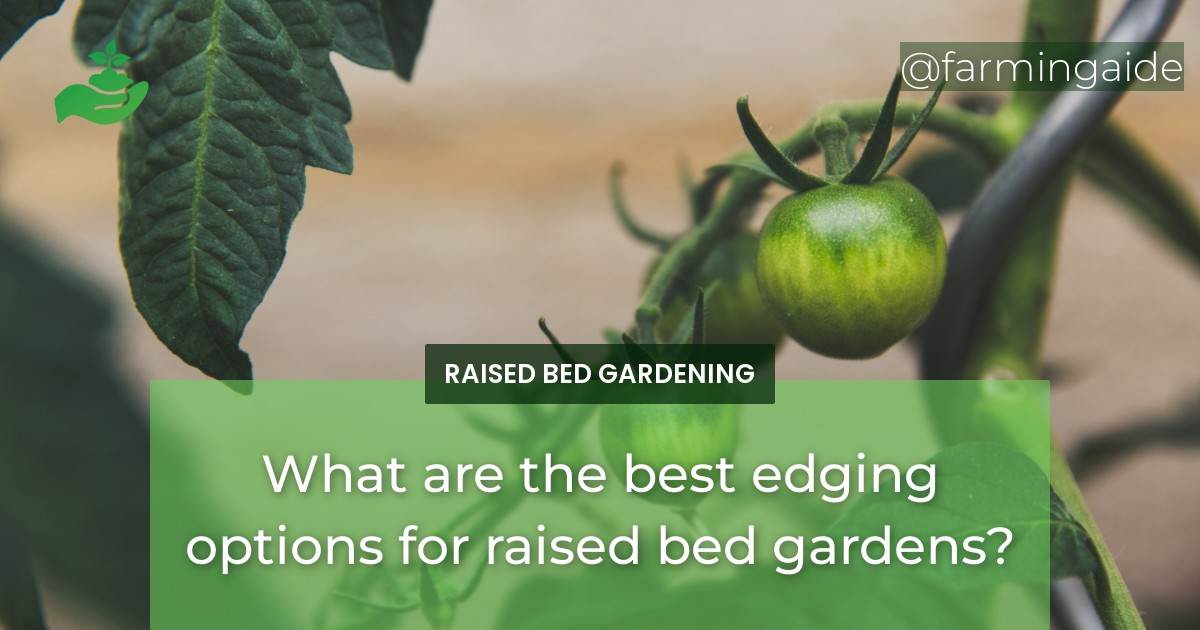Choosing the right edging option for raised bed gardens is an essential aspect of gardening. The right edging provides a distinct look to the garden and helps contain the soil and plants, prevent erosion, and define garden space. There are various edging options available, including wood, stone, brick, metal, and plastic. It is essential to consider factors like durability, cost, ease of installation, aesthetics and style, and compatibility with the garden design before selecting an edging option. Each edging option has its pros and cons, and it is crucial to weigh them during the selection process. In this article, we will explore the various edging options for raised bed gardens, factors to consider when selecting an edging option, and the pros and cons of each edging option.
Why do you need edging for raised bed gardens?
Before diving into the various edging options, it’s essential to understand why one needs edging for raised bed gardens. Here are some reasons:
Contain soil and plants
Raised bed gardens require the soil to be contained within the bed. Edging helps hold the soil and prevents it from spilling over. Additionally, edging can prevent plants from spreading outside the bed and invading other areas of the garden.
Aesthetics and defining garden space
Edging options can significantly impact the look and feel of your garden. They help define garden space, and the right edging can give your garden a polished look. Edging also helps separate the raised bed from other areas in the garden, making it easier to maintain.
Prevent erosion
Raised bed gardens can be susceptible to erosion because of their height. Edging can prevent soil erosion by holding the soil in place.
Types of edging options for raised bed gardens
Here are some of the most common edging options for raised bed gardens:
Wood
Wood is a popular edging option for raised bed gardens because it’s relatively inexpensive and easy to work with. It’s also a great option if you want a natural look for your garden. You can choose from a variety of wood types, including cedar, redwood, and pressure-treated pine.
Stone
Stone is a durable and long-lasting edging option for raised bed gardens. It’s also a great option if you want to give your garden a natural look. You can choose from a variety of stone types, including limestone, sandstone, and granite.
Brick
Brick is a classic edging option that can give your garden a polished look. It’s relatively easy to install and can last a long time. You can choose from a variety of brick colors and sizes to match your garden’s aesthetic.
Metal
Metal edging is a modern and sleek option for raised bed gardens. It’s durable and long-lasting, but it can be more expensive than other options. You can choose from a variety of metals, including steel and aluminum.
Plastic
Plastic edging is a lightweight and inexpensive option for raised bed gardens. It’s relatively easy to install and can last a long time. However, it may not be as durable as other options, and it may not give your garden the same polished look as other edging materials.
ALSO READ
Factors to consider when selecting edging for raised bed gardens
When selecting an edging option for your raised bed garden, it’s essential to consider the following factors:
Durability and longevity
You want your edging to last a long time. Consider materials that can withstand the elements and will not rot or degrade over time.
Cost
Edging options can vary in price. Consider your budget when selecting an edging option.
Ease of installation
Some edging options are easier to install than others. Consider your DIY skills and the time you have available for installation.
Aesthetics and style
Edging can significantly impact the look and feel of your garden. Consider the aesthetic you want to achieve and the style of your garden when selecting an edging option.
Compatibility with the garden design
Consider how the edging will fit with your garden’s overall design. You want your edging to complement your garden, not detract from it.
Pros and cons of each edging option for raised bed gardens
Wood
Pros:
- Relatively inexpensive
- Easy to work with
- Natural look
Cons:
- May not last as long as other options
- Can rot or degrade over time
Stone
Pros:
- Durable and long-lasting
- Natural look
- Can prevent erosion
Cons:
- Can be expensive
- May be challenging to work with
Brick
Pros:
- Classic look
- Durable and long-lasting
- Relatively easy to install
Cons:
- Can be expensive
- May require maintenance over time
Metal
Pros:
- Modern and sleek look
- Durable and long-lasting
- Can prevent erosion
Cons:
- Can be expensive
- May not fit with every garden’s aesthetic
Plastic
Pros:
- Inexpensive
- Relatively easy to install
- Can last a long time
Cons:
- May not be as durable as other options
- May not fit with every garden’s aesthetic
ALSO READ
Which Edging Options Work Best for Constructing Raised Beds?
When constructing raised beds, the best materials for raised beds to use for edging are naturally rot-resistant, such as cedar, redwood, or pressure-treated lumber. Concrete blocks and bricks are also popular choices. These options provide durability and a polished look for your garden.
Conclusion
Choosing the right edging option for raised bed gardens is an essential aspect of gardening. There are various options available, including wood, stone, brick, metal, and plastic. It’s important to consider factors like durability, cost, ease of installation, aesthetics and style, and compatibility with the garden design before making a selection. Each option has its pros and cons, and it’s essential to weigh them when making a decision. The right edging option can give your raised bed garden a polished look while also providing functional benefits like soil containment and erosion prevention.


